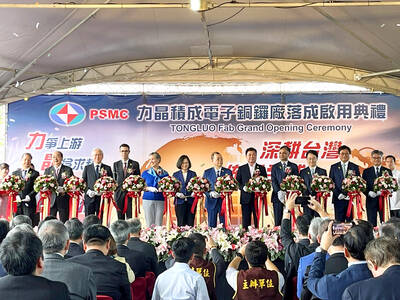The first phase of construction of an offshore wind power operation and maintenance base in Changhua County by Copenhagen Infrastructure Partners (CIP) is to be finished by next year, the company said on Saturday at the center’s groundbreaking ceremony.
The Danish wind energy developer is to build the first offshore and energy port for wind farms in the Asia-Pacific region, CIP said in a statement.
The first phase of the project is to cover a land area of 35 hectares, including 16.86 hectares of port area for maintenance vessels, 3.14 hectares for roads and 15 hectares for industrial use, the company said.
CIP said that project planning began in 2017 and it has since invested more than NT$2 billion (US$67.7 million) in the center to operate the projected Changfang (彰芳) and Xidao (西島) offshore wind farms, set to produce 589 megawatts (MW).
MHI Vestas Offshore Wind A/S, a joint venture between Japan’s Mitsubishi Heavy Industries Ltd and Denmark’s Vestas Wind Systems A/S, is to install the specialized machinery for the project.
The port would feature 10 berths for maintenance vessels, the Changhua County government said.
CIP said the center is expected to boost local industries such as logistics, electrical and machinery services, and the hospitality sector.
CIP, a fund management company founded in 2012, is one of seven companies, including three foreign developers, that in April 2018 won Ministry of Economic Affairs tenders to build 10 offshore wind energy farms, with a combined capacity of 3,836MW, as part of the government’s efforts to develop renewable energy capacity.
The three foreign developers, Danish companies CIP and Orsted A/S, as well as Germany’s Wpd AG, account for 66 percent of the total capacity projected in the ministry’s tender.

BUSINESS UPDATE: The iPhone assembler said operations outlook is expected to show quarter-on-quarter and year-on-year growth for the second quarter Hon Hai Precision Industry Co (鴻海精密) yesterday reported strong growth in sales last month, potentially raising expectations for iPhone sales while artificial intelligence (AI)-related business booms. The company, which assembles the majority of Apple Inc’s smartphones, reported a 19.03 percent rise in monthly sales to NT$510.9 billion (US$15.78 billion), from NT$429.22 billion in the same period last year. On a monthly basis, sales rose 14.16 percent, it said. The company in a statement said that last month’s revenue was a record-breaking April performance. Hon Hai, known also as Foxconn Technology Group (富士康科技集團), assembles most iPhones, but the company is diversifying its business to

ARTIFICIAL INTELLIGENCE: The chipmaker last month raised its capital spending by 28 percent for this year to NT$32 billion from a previous estimate of NT$25 billion Contract chipmaker Powerchip Semiconductor Manufacturing Corp (力積電子) yesterday launched a new 12-inch fab, tapping into advanced chip-on-wafer-on-substrate (CoWoS) packaging technology to support rising demand for artificial intelligence (AI) devices. Powerchip is to offer interposers, one of three parts in CoWoS packaging technology, with shipments scheduled for the second half of this year, Powerchip chairman Frank Huang (黃崇仁) told reporters on the sidelines of a fab inauguration ceremony in the Tongluo Science Park (銅鑼科學園區) in Miaoli County yesterday. “We are working with customers to supply CoWoS-related business, utilizing part of this new fab’s capacity,” Huang said, adding that Powerchip intended to bridge

Microsoft Corp yesterday said that it would create Thailand’s first data center region to boost cloud and artificial intelligence (AI) infrastructure, promising AI training to more than 100,000 people to develop tech. Bangkok is a key economic player in Southeast Asia, but it has lagged behind Indonesia and Singapore when it comes to the tech industry. Thailand has an “incredible opportunity to build a digital-first, AI-powered future,” Microsoft chairman and chief executive officer Satya Nadella said at an event in Bangkok. Data center regions are physical locations that store computing infrastructure, allowing secure and reliable access to cloud platforms. The global embrace of AI

Qualcomm Inc, the world’s biggest seller of smartphone processors, gave an upbeat forecast for sales and profit in the current period, suggesting demand for handsets is increasing after a two-year slump. Revenue in the three months ended in June will be US$8.8 billion to US$9.6 billion, the company said in a statement Wednesday. Excluding certain items, earnings will be US$2.15 to US$2.35 a share. Analysts had projected sales of US$9.08 billion and earnings of US$2.16 a share. The outlook signals that the smartphone market has begun to bounce back, tracking with Qualcomm’s forecast that demand would gradually recover this year. The San